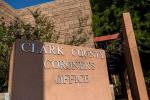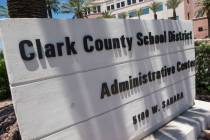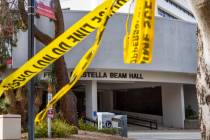2 Las Vegas-area colleges get federal Hispanic student grants
Two Las Vegas Valley colleges are each receiving more than $2 million in federal money aimed at helping schools with a large number of Hispanic students.
This month, the College of Southern Nevada and Nevada State College separately announced they are receiving a grant through the U.S. Department of Education’s Developing Hispanic-Serving Institutions Program. Both schools have a federal Hispanic-Serving Institution (HSI) designation, which means at least 25 percent of their students identify as Hispanic.
CSN plans to use a five-year, $2.9 million grant to launch a new program to help guide students through college-level math classes.
NSC’s School of Education will receive a five-year, $2.73 million grant. The money will be used for continuing to build out teacher academy projects in partnership with Clark County School District high schools, improving agreements to help provide students at community colleges with a more seamless transition to NSC, and expanding a partnership with the school district on an alternative route to licensure program.
“The School of Education has gone all-in for helping our state locally grow more of its teachers,” Dean Dennis Potthoff said.
There’s a nationwide teacher shortage, which also affects Nevada. Clark County School District spokesman Mauricio Marin said Monday that about 400 teaching positions are currently vacant in the district. That’s down from 566 that were open as of July 29.
Marin said the district is happy to work with partners to ensure there are licensed educators for students and it is working to help diversify its teaching pipeline.
Critical labor shortages
During a school board meeting in mid-May, the Clark County School Board voted to redesignate several job categories — special education; middle and high school math, science and English; elementary school grades (preschool through fifth); bus drivers; and substitute teachers — as critical labor shortage areas beginning July 1 for a two-year period.
“Because there are some teaching areas that are difficult to attract and retain teachers due to various labor shortages, the Nevada Legislature previously authorized the hiring of retired employees for designated critical labor shortage areas …” school district officials wrote in meeting materials.
The district had about 890 open teaching positions in 2015, but that number dropped sharply after the state Legislature created a teacher incentive program that year. The district had 325 vacancies during the 2016-17 school year, but numbers have since risen again. When last school year began, CCSD had about 750 open teaching positions.
Nevada State College’s grant
NSC, which has more than 5,500 students at its Henderson campus, will use its new federal grant to support the School of Education’s work with CCSD and other Nevada school districts, the college said in a statement this month.
It is the second Developing Hispanic-Serving Institutions Program grant NSC has received. The first — a five-year, $2.5 million grant — was awarded three years ago.
The new grant begins in October and will help the college “build upon the things we set out to accomplish in the first grant,” Potthoff said.
The federal grant is oriented toward helping people of Latinx descent who want to teach, but “obviously, we want teachers of all ethnicities,” Potthoff said.
About 47 percent of CCSD students identify as Hispanic or Latino. One of the goals with the grant is for the teacher workforce to more closely mirror the diversity in the school district, Potthoff said.
Teacher pipeline
Melanie Murray, director of K-12/college partnerships and field experiences at NSC, was the lead writer for the college’s grant application. She said the college is looking at teacher recruitment all the way through retention, including providing mentorship and resources. “We’re focusing on all of those parts and making sure they just have support in whatever pathway they choose.”
That includes to educate people on what teaching looks like as a career and “develop a positive narrative around teaching,” she said.
CCSD has a career and technical education program called teaching and training, Potthoff said, and 29 high schools are participating. Unofficial numbers — provided to the Review-Journal by NSC — show the district has 3,731 high school students participating in the program this fall.
NSC’s School of Education, via the Nevada State College Teacher Academy Pipeline Project, is working directly with 12 of the 29 high schools, Potthoff said.
By the time participating students graduate from high school, they have started on the pathway toward an education degree, he said. “We’re really excited about the opportunity to expand dual credit programs for those eligible in those high schools.”
NSC is also involved with the school district’s alternative route to licensure teacher training program. It is for adults who have at least a bachelor’s degree who are interested in pursuing a career change to become a teacher.
Accelerated Licensure Teacher Academy (ALTA) has about 150 to 180 candidates go through the program each year, Marin said. Participants must pass competency exams to be considered for acceptance into the program and then attend a 10-week boot camp and spend 20 days in a CCSD classroom placement.
CCSD says the program is one of the “most affordable certification programs in the nation,” with participants paying a $500 training fee and $55 background check fee.
“Upon successful completion of the Academy, teachers can apply for a conditional teaching license,” according to CCSD’s website.
After that, teachers have up to three years to complete coursework they need to qualify for a standard teaching license with the state. In fall 2021, NSC will become the designated provider of coursework for students in the ALTA program to get licensed.
College of Southern Nevada
The College of Southern Nevada — a community college with three main campuses in the Las Vegas Valley and about 27,000 students — received a $2.9 million, five-year grant to launch a program to help guide students through college-level math classes.
About one-third of CSN’s students identify as Hispanic. The college was the state’s first Hispanic-Serving Institution.
The new program — El Mapa Matemático/Math Map program — “guides students through college-level math by integrating the college’s efforts at four milestones on the student’s journey: placement, support, instruction, and pre-graduation,” the college said in a news release this month.
CSN President Federico Zaragoza said in the release: “At CSN, we want to ensure that every student who wants to graduate does. Many students struggle with college level math. We have offered free tutorial assistance to our students for years, and now we’re thrilled that we can add yet another tool to our Students First approach.”
Contact Julie Wootton-Greener at jgreener@reviewjournal.com or 702-387-2921. Follow @julieswootton on Twitter.




























